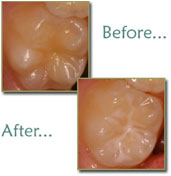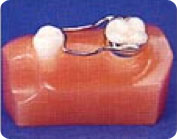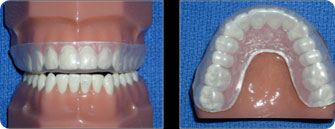Preventative Procedures
I. Sealants
a) Resin Sealants
Sealants are "coatings" that are applied to teeth with deep grooves to prevent cavities. The most common surface of the tooth that a sealant protects is the top or the occlusal surface. The teeth that are susceptible occlusal caries (cavities) are the first permanent molars, which erupt into the mouth at six years of age. Sometimes it is appropriate to seal the primary molar teeth and permanent premolar teeth, depending on the steepness of the grooves and the caries risk (likelihood of your child developing cavities) of the patient.

There are two types of sealants available today. The most traditional form requires the tooth's occlusal surface to be completely erupted in the mouth and be tall enough to be isolated. These usually involve the placement of either unfilled or filled resin on the surface of the tooth. In order for the resin to "stick" the tooth must be cleaned either with pumice or air abrasion and the surface etched with phosphoric acid. The resin is applied and "set" or hardened with a light. All this should take place in a dry environment, which is best achieved with the placement of a rubber dam. More than 60% of occlusal caries can be prevented with this procedure. Sealants are "man-made" and therefore require follow-up and sometimes "touch-ups" as they typically last 2 – 3 years.
What about Bis-Phenol A?
Bis-phenol A is a by-product found when some plastics are produced. It is not found in all plastics. Bis-phenol A has been found in the saliva of some patients after sealants have been placed. All the products we use are carefully selected for the use not only in your child's mouth but in our children as well. The sealants we use have no Bis-phenol A by-product. It has been shown that the majority of the Bis-phenol A by-product is released at the surface of a newly placed sealant. Thus we remove this smear layer with a cotton pellet, as a precaution with all the sealants we place.
b) Glass Ionomer
Sealants
The other form of a sealant is a glass ionomer coating. The glass ionomer coating does not require the same isolation requirements as a resin sealant. However, it also does not last as long as a resin sealant and is usually used as an intermediate treatment. So why use it? It can be used when teeth are susceptible to occlusal caires, but not fully erupted. These teeth cannot be properly isolated for a resin sealant but already have evidence of caries activity. The glass ionomer can be placed without a rubber dam with minimal tooth preparation. In addition to physically filling the grooves, this material releases fluoride onto the susceptible occlusal surface which can allow for remineralisation (strengthening) of the enamel surface. Since this material is not strong and will eventually wear off, it is usually replaced with a resin sealant once the tooth is fully erupted.
II. Space Maintainers
The purpose of a space maintainer is to hold space within the dental arch. When primary teeth are lost prematurely, this allows the remaining adjacent teeth to drift into the space thus potentially blocking the correct position of the erupting adult teeth and in severe cases preventing the adult tooth from erupting. Spacers are constructed of a stainless steel band which fits around one tooth and a soldered bend wire which touches the next tooth. They can be uni-lateral, which means that they are restricted to one side of the arch or bi-lateral, which means that they extend from one side to the other side of the same arch. Spacers are usually cemented into place with glass ionomer cement. The length of time they are required depends on the dental development of your child.

III. Mouth Guards
The purpose of mouth guards are to protect the teeth and jaw from traumatic injuries. They are highly recommended when your children are involved in sports activities. Although they only last for one season – due to your child's growth – they usually fit better and thus your child is more likely to wear it.
We use a vacuum suction to mold the plastic material over the impression of your child's teeth.

